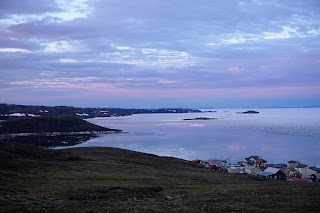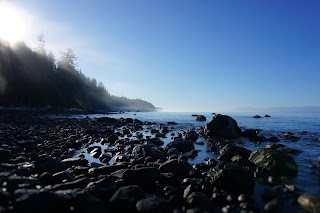“Trip partner(s) wanted: remote ~12 day traverse in Mount
Edziza Park in northern BC, across the Spectrum Range and along Mt. Edziza. It
will be a challenging trip (no trail), but non-technical. Float plane charter
into Little Ball Lake and flight out of Buckley Lake.”
| Amazing colours of the Spectrum Range (Photo: Jordan Anderson) |
With a successful hike behind us, we finalized plans. Jordan
proved to be a stellar route planner and navigator, targeting nine days of
hiking. I organized the food. There were meticulous gear lists, nutrition tables,
some emails and phone calls.
I met Jordan in Smithers, BC on August 1. Gear quickly
overflowed the motel room. By evening’s end we had two backpacks ready to go. The
next day we drove six and a half hours north to Tatogga Lake Resort to meet our
Alpine Lakes Air charter.
As the float plane left us alone, we felt the elation of having
arrived in a vast wilderness without an escape route; a world of self-reliance
and trust in each other. The saturated alpine landscape immediately embraced
us. Its bright blue skies welcomed us as the evening sun began to draw long
shadows. Mountains in every shade of gold were capped by pristine snow fields.
Green patches interrupted the creek bed gravel.
| Day 2 - Camping spot (Photo; Inga) |
We shouldered our packs, rounded the lake and started up
valley.
Northern summer days afford the luxury of late starts and
long days. To me, these latitudes offer the best kind of hiking; and Jordan
came to relax about not striking out by 8 am every day.
Day two brought us across our first pass and an abundance of
ever changing colours creating countless impressions of the Spectrum Range. I slowly
found my uphill legs; and then eased the knee-busting downhills with a
well-practiced handling of hiking poles.
| 500 metres uphill on loose scree. (Photo J Anderson) |
We took note of obsidian littering the landscape. Obsidian
reminds us that this provincial park is part of the Tahltan Highlands. The
Tahltan people - the original people of this spectacular wilderness - have not
given up Aboriginal Title to their territory. Edziza obsidian, the dark
volcanic glass used to make sharp tools in ancient times, was used and traded
by the Tahltan and has been found on the west coast and in territories toward
the east. The human story here reaches back to time immemorial; as visitors we respect
the land by leaving no trace and taking nothing but photos.
At the end of our first full day of hiking, we contemplated
the second significant pass of this traverse and decided to tackle the 500-metre
ascent the next morning. While I set up camp on a knoll, Jordan descended a few
hundred meters to fetch water. We settled into our new camp routine and enjoyed
stupendous evening views across this huge valley.
| Day 4 - we climbed most of this scree slope side-by-side as boulders kept falling into the valley. (Photo: J Anderson) |
Day three started out fine: Our plan was to take the direct
route up and veer left at about 2,100 metres toward the low end of the ridge to
avoid the glacier on the North-side. Alternating between the direct line and
zig-zags, we carefully navigated the continuous movement of boulders. This
scree slope exhaled and settled with each step.
As we progressed upwards we reached the edge of the clouds
and visibility was reduced to as little as 20 or 30 metres. I trailed Jordan. As
the weather moved in, we lost sight of each other and proceeded to
independently execute the plan. When I reached the ridge, now fully engulfed in
a cold, lashing rain and sleet, I found Jordan greatly relieved.
In full rain gear and after a quick snack, we crossed to the
other side and realized that we needed to go further left to reach the rocks
and mud rather than get caught in a potentially uncontrollable descent of the
glacier itself. As we lost elevation we left the clouds for a time, took short
breaks, replenished our water bottles and encountered two very curious mountain
goats; their climbing skills clearly outdid ours.
Drenched to the skin we spent the next several hours moving
across another dazzling valley, up another high pass onto a large plateau. With
the change in elevation the stormy weather returned and we set up camp in the
rain. Shivering and unable to light the stove we decided to forgo a hot dinner
in favour of stripping off our wet clothes and crawling into our dry sleeping
bags. The weather didn’t relent. We faced the next day knowing we didn’t have
much margin left if the weather didn’t improve: after breakfast we set out in soaked
boots and soggy clothes motivated to move and stay warm.
| Highly dynamic jump with a 55+ pound pack. (Photo: Inga) |
Finally that afternoon the weather broke. We kept moving
through this wilderness, grateful for the warmth of the sun, taking each scree
slope and pass in good humour to balance the dangers, astounded by Mount Edziza
- the “Ice Mountain”, admiring near perfect volcanic cinder cones, glad for low
running creeks and thoughtful about crossing the others.
We completed the traverse on day 7 with a final push of more than 30 km to Buckley Lake. A rare 8 am start ensured that we crossed every creek by rock hoping and arrived 11.5 hours later at the dock on Buckley Lake. To our amazement we found ourselves walking into Creyke’s hunting camp that Leonard Creyke and members of his family were visiting. He had spent years guiding in the area; this was his first visit in some time. It was a remarkable conclusion to this journey: sharing an evening of conversation, stories of his Tahltan family and the sacred land we had walked, and a dinner of freshly caught lake trout.
We completed the traverse on day 7 with a final push of more than 30 km to Buckley Lake. A rare 8 am start ensured that we crossed every creek by rock hoping and arrived 11.5 hours later at the dock on Buckley Lake. To our amazement we found ourselves walking into Creyke’s hunting camp that Leonard Creyke and members of his family were visiting. He had spent years guiding in the area; this was his first visit in some time. It was a remarkable conclusion to this journey: sharing an evening of conversation, stories of his Tahltan family and the sacred land we had walked, and a dinner of freshly caught lake trout.
| Mount Edziza. |
(As submitted to the Alpine Club of Canada, Gazette)



















